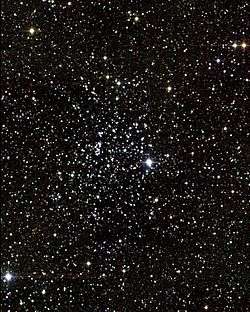Messier 52
Messier 52 or M52, also known as NGC 7654, is an open cluster of stars in the northern constellation of Cassiopeia. It was discovered by Charles Messier on September 7, 1774.[2] M52 can be seen from Earth with binoculars. The brightness of the cluster is influenced by extinction, which is stronger in the southern half.[5]
| Messier 52 | |
|---|---|
 | |
| Observation data (J2000 epoch) | |
| Constellation | Cassiopeia |
| Right ascension | 23h 24m 48.0s[1] |
| Declination | +61° 35′ 36″[1] |
| Distance | 4.6 kly (1.4 kpc)[1] |
| Apparent magnitude (V) | 5.0 |
| Apparent dimensions (V) | 13.0′[2] |
| Physical characteristics | |
| Mass | 1,200 M☉[3] M☉ |
| Radius | 9.5 ly[2] |
| Estimated age | 158.5 Myr[1] |
| Other designations | NGC 7654, Cr 455, C 2322+613, OCl 260[4] |
R. J. Trumpler classified the cluster appearance as II2r, indicating a rich cluster with little central concentration and a medium range in the brightness of the stars.[6] This was later revised to I2r, denoting a dense core.[5] The cluster has a core radius of 2.97 ± 0.46 ly (0.91 ± 0.14 pc) and a tidal radius of 42.7 ± 7.2 ly (13.1 ± 2.2 pc).[3] It has an estimated age of 158.5 million years[1] and a mass of 1,200 M☉.[3]
The magnitude 8.3 supergiant star BD +60°2532 is a probable member of M52.[3] The stellar population includes 18 candidate slowly pulsating B stars, one of which is a δ Scuti variable, and three candidate γ Dor variables.[7] There may also be three Be stars.[8] The core of the cluster shows a lack of interstellar matter, which may be the result of supernovae explosions early in the cluster's history.[5]
References
- Wu, Zhen-Yu; et al. (November 2009), "The orbits of open clusters in the Galaxy", Monthly Notices of the Royal Astronomical Society, 399 (4): 2146–2164, arXiv:0909.3737, Bibcode:2009MNRAS.399.2146W, doi:10.1111/j.1365-2966.2009.15416.x.
- Adam, Len (2018), Imaging the Messier Objects Remotely from Your Laptop, The Patrick Moore Practical Astronomy Series, Springer, p. 241, Bibcode:2018imor.book.....A, ISBN 978-3319653853
- Bonatto, C.; Bica, E. (September 2006), "Methods for improving open cluster fundamental parameters applied to M 52 and NGC 3960", Astronomy and Astrophysics, 455 (3): 931–942, arXiv:astro-ph/0608022, Bibcode:2006A&A...455..931B, doi:10.1051/0004-6361:20065315
- "M 52". SIMBAD. Centre de données astronomiques de Strasbourg. Retrieved November 28, 2018.
- Pandey, A. K.; et al. (August 2001), "NGC 7654: An interesting cluster to study star formation history", Astronomy and Astrophysics, 374 (2): 504–522, Bibcode:2001A&A...374..504P, doi:10.1051/0004-6361:20010642.
- Trumpler, Robert Julius (1930), "Preliminary results on the distances, dimensions and space distribution of open star clusters", Lick Observatory Bulletin, 420: 154–188, Bibcode:1930LicOB..14..154T, doi:10.5479/ADS/bib/1930LicOB.14.154T.
- Luo, Y. P.; et al. (February 2012), "Discovery of 14 New Slowly Pulsating B Stars in the Open Cluster NGC 7654", The Astrophysical Journal Letters, 746 (1): 5, Bibcode:2012ApJ...746L...7L, doi:10.1088/2041-8205/746/1/L7, L7.
- Bond, Howard E. (August 1973), "Be Stars in the Galactic Cluster M 52", Publications of the Astronomical Society of the Pacific, 85 (506): 405, Bibcode:1973PASP...85..405B, doi:10.1086/129477.
External links

- Messier 52, SEDS Messier pages
- Messier 52 on WikiSky: DSS2, SDSS, GALEX, IRAS, Hydrogen α, X-Ray, Astrophoto, Sky Map, Articles and images
